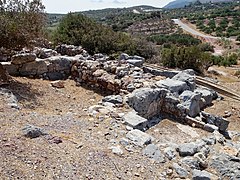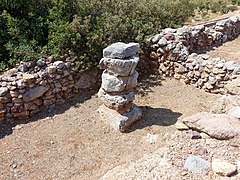Minoan villa of Zakros
The Minoan Villa of Zakros ( Greek Μινωική έπαυλη Ζακρού Minoiki epavli Zakrou ) refers to an archaeological excavation site in the east of the Greek island of Crete . It is located in the municipality of Sitia in the Lasithi regional district , immediately south of the village of Zakros ( Ζάκρος ), also known as Epano Zakros ( Επάνω Ζάκρος 'Upper Zakros'), on the road to Kato Zakros. The generic term "Minoan villa" describes a type of building that is largely limited to the new palace period of the Minoan culture .
history
The excavation site, recorded under the name of Koukou Kefali 1 , was partially explored by the British archaeologist David Hogarth as early as 1901 . In the mid-1960s, construction work was carried out on the road that leads directly over the remains of the "Minoan Villa". This was the reason for further excavations by the Greek archaeologist Nikolaos Platon , supported by Efi and Giannis Sakellarakis . In the 1970s there were re-excavations by the Greek archaeologist Alexandra Karetsou.
The building of the "Minoan villa" of Zakros is the Late Minoan period SM I dated. It was built on the slope of a hill on at least three levels or terraces. Today the road to Kato Zakros, the location of the Minoan palace of Zakros, runs over the upper level . A wine press was found in a room on the lower level of the “villa”. It consisted of two winepress vessels, clay pans, walled into a workbench, which are attributed to the period SM I A. Fragments of floral frescoes that were found in the backfill layer of the room indicate a decoratively designed upper floor that must have been above the room.
A room on the middle level of the building has a channel in the floor, which may have served as a manual work device. In another room on this level there is a central column. It contained eight large pithoi . There was a linear A inscription on one of the storage vessels , which begins with the ideogram for wine and a number. The two lines of the inscription on the pithos read:
- wainu 21 .di-di-ka-se.a-ša-mu-ne.a-se ('wine, 21 liquid measurement standard units : (supplied by) Di-di-ka-se; the pithos: (supplied by) A- se ')
- a-ṭạ-nū-tī de-ka.a-re ma-re-na.ti-ti-ku ('I, Titikos, have given this to our guild master ')
The individual words have Semitic equivalents . So correlated a-sa-mu-ne with the Semitic assammû + -n and designates the vessel name ( Greek πίθος Pithos ), a-ta-nu-ti like 'tnt for "I gave" de-ka corresponds DEK- for " this, that “, a-re stands for 'alēy- “ to, for ”and ma-re-na or Semitic mr' + -n is a word for“ our guild master ”.
- Excavation site
literature
- Stefan Hiller : The Minoan Crete after the excavations of the last decade (= Fritz Schachermeyr [Hrsg.]: Mykenische Studien . Volume 5 ). Publishing house of the Austrian Academy of Sciences, Vienna 1977, ISBN 978-3-7001-0176-5 , Minoan country seats, p. 157 .
- Sabine Westerburg-Eberl: "Minoan Villas" in the New Palace period on Crete . In: Harald Siebenmorgen (Ed.): In the Labyrinth of Minos: Crete - the first European high culture [Exhibition of the Badisches Landesmuseum, 27.1. until April 29, 2001, Karlsruhe, Schloss] . Biering & Brinkmann, Munich 2000, ISBN 3-930609-26-6 , pp. 87–95 ( archiv.ub.uni-heidelberg.de [PDF; 1.6 MB ]).
- Eleni Mantzourani, Giorgos Vavouranakis: Megalithic versus Status: The Architectural Design and Masonry of Exceptional Late Bronze Age I Buildings in East Crete . In: Mediterranean Archeology and Archaeometry . tape 5 , no. 2 . MAA, 2005, Epano Zakros, p. 41–43 (English, digitized version [PDF; 2.0 MB ; accessed on January 14, 2018]).
- Eleni Mantzourani, Giorgos Vavouranakis: The Minoan Villas in East Crete: Households or Seats of Authority? The Case of Prophitis Ilias Praisou . In: Kevin T Glowacki, Natalia Vogeikoff-Brogan (Ed.): Stega. The archeology of houses and households in ancient Crete (= Hesperia Supplement . Volume 44 ). The American School of Classical Studies at Athens, Athens 2011, p. 125-135 , JSTOR : 41363146 .
Individual evidence
- ↑ Sabine Westerburg-Eberl: "Minoan Villas" in the New Palace period on Crete . In: Harald Siebenmorgen (Ed.): In the Labyrinth of Minos: Crete - the first European high culture [Exhibition of the Badisches Landesmuseum, 27.1. until April 29, 2001, Karlsruhe, Schloss] . Biering & Brinkmann, Munich 2000, ISBN 3-930609-26-6 , pp. 87 ( archiv.ub.uni-heidelberg.de [PDF; 1.6 MB ]).
- ↑ Dana Facaros, Michael Pauls: Crete . New Holland Publishers, London 2003, ISBN 1-86011-106-8 , pp. 260 (English, digitized version ).
- ↑ Ierapetra - Zakros. Alpha & Omega, accessed October 5, 2016 .
- ↑ The Minoan Villa of Pano Zakros. Municipality of Sitia, accessed October 5, 2016 (English, 2013-2016).
- ↑ a b Zakros: Koukou Kefali 1. Archaeological Atlas of Crete: Archaeological Sites. Forth: Institute for Mediterranean Studies, accessed October 5, 2016 .
- ↑ Eleni Fragkaki: A Critical Analysis of the Site and Landscape of Zakros, in the context of the Minoan palaces of Crete. Dissertation, University College London 2009, p. 35 (English, digitized version ).
- ↑ a b c Epano Zakros. Minoan Crete, July 12, 2015, accessed October 5, 2016 .
- ↑ a b c Sabine Westerburg-Eberl: "Minoan Villas" in the New Palace period on Crete . In: Harald Siebenmorgen (Ed.): In the Labyrinth of Minos: Crete - the first European high culture [Exhibition of the Badisches Landesmuseum, 27.1. until April 29, 2001, Karlsruhe, Schloss] . Biering & Brinkmann, Munich 2000, ISBN 3-930609-26-6 , pp. 91 ( archiv.ub.uni-heidelberg.de [PDF; 1.6 MB ]).
- ^ FR Riley: The Olive Industry of Bronze Age Crete: Evidence for Volcanic Damage to Olive Groves and Property in Central and Eastern Crete. (PDF) akroterion.journals.ac.za, accessed on October 5, 2016 (English, 1.5 MB).
- ^ Jan Gijsbert-Peter Best: A Linear A Inscription on a Pithos from Epanô Zakro . In: Talanta . tape 4 , 1972, p. 82–84 (English, talanta.nl [PDF; 987 kB ]).
- ↑ Jan P. Stronk: A Pithos from Epanô Zakro . In: Talanta . tape 4 , 1972, p. 85–87 (English, talanta.nl [PDF; 691 kB ]).
- ^ Jan Gijsbert-Peter Best: The Zakro Pithos Inscription, Again . In: Talanta . tape 14-15 (1982/1983) , pp. 9–13 (English, talanta.nl [PDF; 6.2 MB ]).
- ^ Robert R. Stieglitz: The Minoan Pithos Inscription from Zakro . In: Wolfgang Blümel (Ed.): Kadmos . tape 22 , 2009, ISSN 1613-0723 , p. 5-7 (English, abstract ).
- ^ Jan Gijsbert-Peter Best, Fred C. Woudhuizen : Lost Languages from the Mediterranean . Brill, Leiden 1989, ISBN 90-04-08934-9 , pp. 27 (English, digitized version ).
- ^ A b Fred C. Woudhuizen: Documents in Minoan Luwian, Semitic, and Pelasgian (= Publications of the Henri Frankfort Foundation . Volume 14 ). Dutch Archaeological and Historical Society, Amsterdam 2016, ISBN 978-90-72067-19-7 , Language (s) of Linear A, pp. 229-230 (English, online ).
Web links
- Zakros: Koukou Kefali 1. In: Digital Crete: Archaeological Atlas of Crete. Foundation for Research and Technology-Hellas (FORTH), Institute for Mediterranean Studies(English).
Coordinates: 35 ° 6 ′ 26.4 ″ N , 26 ° 13 ′ 9.7 ″ E




